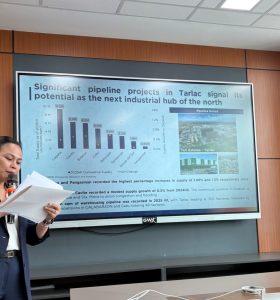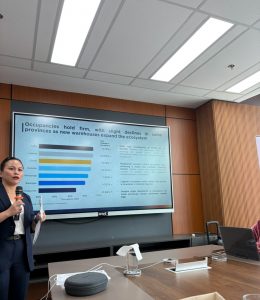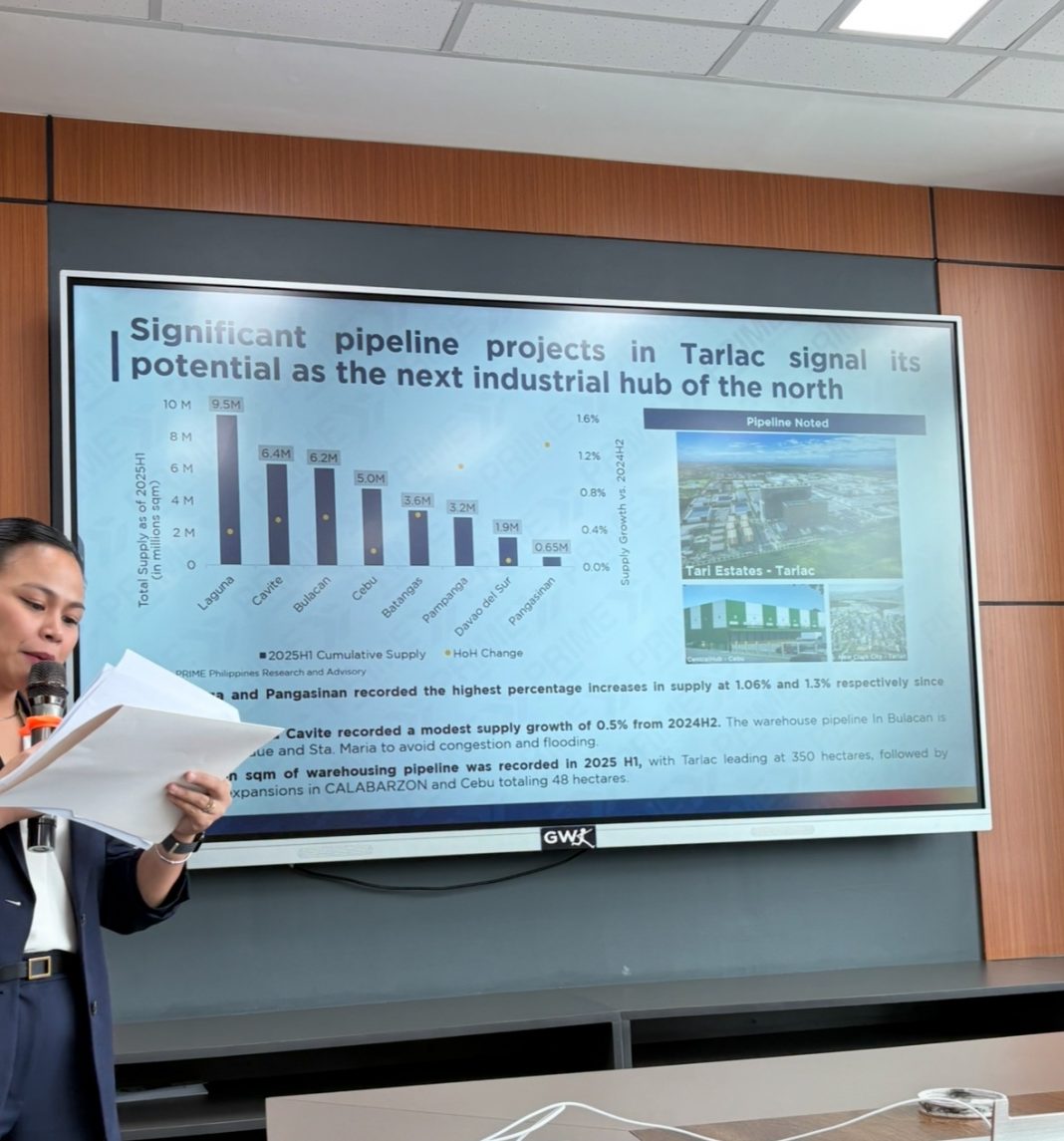Demand for industrial property suited for warehouse and storage development in the first half this year has grown a tremendous 80 percent, a robust growth that started since the second half of 2024, along with similar growth in the overall industrial market, according to a report by the country’s fastest growing property consultancy firm — PRIME Philippines.
During a presentation for its Mid-Year Media Briefing, Joy Rosario, head of Industrial Market Division at PRIME Philippines, delved into the evolving logistics, warehousing, and industrial landscape shaping business decisions today.
“Warehouse demand rose by a significant 80 percent since 2024 H2, but more importantly, we’re not just seeing volume, we’re seeing expansion in coverage,” said Rosario.
The robust demand for warehouses just mirrored the 80 percent increase in overall industrial demand to 691,900 square meters in the first six months of the year from 383,800 sqm in the second half of 2024.
What is more telling is that growth is not only happening in the demand side, but the average size of each requirement is also getting larger, especially in the retail and logistics firms, said Rosario.
Hotspots
Another highlight in the report is that demand hotspots have expanded into key provinces.

According to Rosario, previously underserved regions such as La Union, Bataan, Nueva Ecija, and Isabela are getting attention driven by aggressive wholesale and retail sector expansions, including PRIME Philippines’ 3-hectare transaction in Bicol—a first for South Luzon’s industrial frontier.
This increase in warehouse size per locator reflects a deeper trend: companies are consolidating operations to meet faster, larger, and more complex consumer needs, especially for e-commerce fulfillment and regional distribution.
For instance, Bulacan received the highest share of requirements, while Davao surged from 1,600 to 18,000 sqm—signaling that demand is expanding outside traditional zones and tapping into growth markets across the country.
Supply
On the supply side, PRIME recorded 3.98 million sqm of new warehousing pipeline in the first half this year —a strong indicator of continued developer confidence.
There are also an additional 1.5 million sqm, with Cavite, Laguna, and Pampanga as prime targets for developers due to expressway access, proximity to ports, and availability of developable land.
Pampanga leads in Central Luzon, with hotspots like Mabalacat, Porac, and San Fernando attracting dry warehouses due to access to NLEX and Clark Airport.
Bulacan’s pipeline is shifting to Bocaue and Sta. Maria, avoiding flood-prone zones while staying close to Metro Manila.
Cavite remains steady, with General Trias, Carmona, and Silang maintaining strong appeal due to direct links to SLEX and CALAX.
“We’re also seeing growing interest in Pangasinan—tapped as a future logistics hub beyond Pampanga and Bulacan, with full potential expected by 2028,” she said.
The biggest pipeline story, however, is Tarlac—home to massive projects like Tari Estates and New Clark City. With large tracts of land and infrastructure like SCTEX and TPLEX, Tarlac is emerging as the next major logistics corridor in the North.
Most importantly, Rosario said, almost 80 percent of the new supply now meets global warehouse standards—with features like elevated loading bays, higher ceilings, and sustainability elements such as solar-ready roofs. This shift reflects how tenants are demanding more efficient, automation-ready spaces aligned with global logistics trends.
Even Cebu is catching up, with expansions like West Cebu Estate and CentralHub—signaling that warehousing growth is no longer Luzon-centric, but nationwide and future-focused.
Occupancy
Based on its report key provinces continue to hold firm with occupancy rates above 94 percent, even as supply has grown by 8 percent since 2024H1. This reflects sustained tenant confidence despite new inventory entering the market.

“Occupancies across key industrial provinces remain strong despite shifting tenant behaviors and emerging submarkets,” she said.
Cebu leads the country with a 97.9 percent occupancy rate as of 2025H1. The province’s industrial zones in Mandaue and Minglanilla are now saturated, pushing tenants northward to Liloan and Consolacion where infrastructure is expanding. With 50,000 sqm of new stock expected by year-end, Cebu’s performance continues to be driven by e-commerce and logistics, and is forecasted to remain healthy even with incoming supply.
In Laguna, Rosario said they observed a slowdown in new leasing activity, occupancy remains stable at 97.77 percent. This is largely due to a base of long-term tenants renewing their leases and limited available stock. Despite quieter demand, confidence remains high—Laguna continues to benefit from its central location, established corridors, and skilled workforce.
Overall, Rosario said that occupancies remain healthy across the board, with tenant shifts driven more by expansion and congestion avoidance rather than any weakening of industrial interest.
Lease rates
Another indicator of strong demand is the lease rates, which have shown steady growth between 0.5 percent to 1.5 percent, driven mainly by premium warehouse entries in major hubs like Pampanga and Laguna. “This signals a healthy level of absorption, not speculation,” she said.
Warehouse lease rates across most key provinces remained relatively stable in 2025H1, with an average growth of 0–2 percent. But this surface stability masks a deeper trend: the rise of premium-grade warehousing.
In Pampanga, Rosario said they saw a sharp 25 percent quarter-on-quarter increase, as rates jumped from PHP160 to PHP 200 per sqm. This spike, however, was not market-wide—it was driven by the launch of high-spec warehouses in San Fernando and Mexico, supported by Pampanga’s improved connectivity via SCTEX and NLEX, and proximity to Clark Airport.
Similarly, Laguna noted a 7.6 percent spike in Q2, with select premium warehouses now quoting up to PHP 500 per sqm.
But just like in Pampanga, most legacy stock remains in the PHP200–300 range, and the average increase is largely due to the inclusion of newer, top-tier developments.
Across the board, stable long-term leases and cautious tenant movement are keeping rates grounded—especially in regions where vacancy is tight but not urgent.
“Lease rate growth is happening—but it’s selective, favoring newer facilities that offer automation-readiness, modern specs, and ESG alignment. This signals an evolving landlord strategy—quality, not just location, is beginning to define pricing power in industrial real estate,” she said.
Demand dynamics across Luzon are evolving, reflecting changes in sector focus and locational strategies.
Overall, Rosario said, “demand isn’t disappearing—it’s redistributing.”
She said, “Companies are recalibrating based on land availability, cost, connectivity, and sector fit—which is reshaping the industrial landscape as we move into the second half of 2025.”




